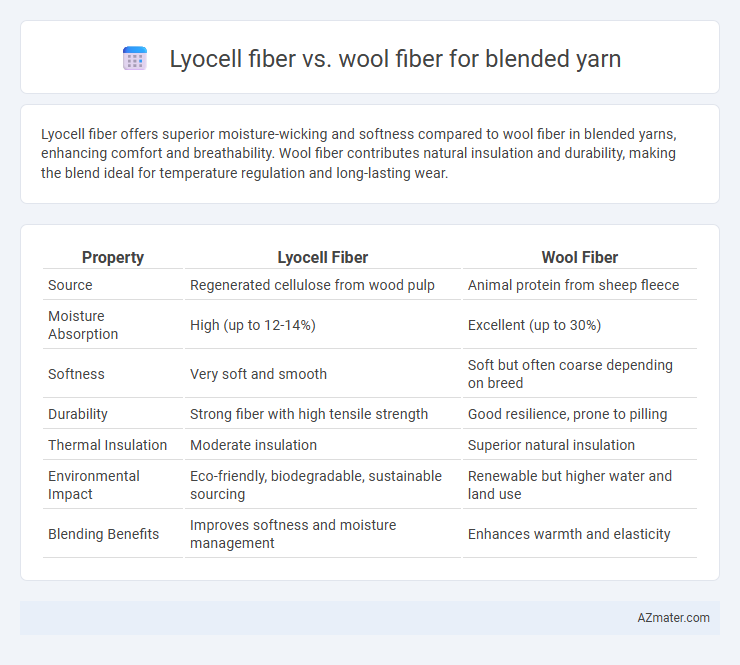Lyocell fiber offers superior moisture-wicking and softness compared to wool fiber in blended yarns, enhancing comfort and breathability. Wool fiber contributes natural insulation and durability, making the blend ideal for temperature regulation and long-lasting wear.
Table of Comparison
| Property | Lyocell Fiber | Wool Fiber |
|---|---|---|
| Source | Regenerated cellulose from wood pulp | Animal protein from sheep fleece |
| Moisture Absorption | High (up to 12-14%) | Excellent (up to 30%) |
| Softness | Very soft and smooth | Soft but often coarse depending on breed |
| Durability | Strong fiber with high tensile strength | Good resilience, prone to pilling |
| Thermal Insulation | Moderate insulation | Superior natural insulation |
| Environmental Impact | Eco-friendly, biodegradable, sustainable sourcing | Renewable but higher water and land use |
| Blending Benefits | Improves softness and moisture management | Enhances warmth and elasticity |
Introduction to Lyocell and Wool Fibers
Lyocell fiber, derived from sustainably sourced wood pulp, offers exceptional moisture absorption, breathability, and a smooth, soft texture ideal for blended yarns. Wool fiber, obtained from sheep fleece, provides superior insulation, elasticity, and natural wrinkle resistance, enhancing durability and warmth in fabric blends. Combining Lyocell and Wool fibers in blended yarns creates a balanced textile with moisture management, comfort, and temperature regulation properties.
Overview of Blended Yarn Applications
Blended yarns combining Lyocell and Wool fibers offer enhanced performance in textile applications such as apparel, upholstery, and technical fabrics. Lyocell contributes moisture-wicking, breathability, and softness, while Wool adds warmth, elasticity, and natural flame resistance. This synergy improves durability and comfort, making it ideal for activewear, winter garments, and eco-friendly fashion products.
Fiber Structure and Composition Comparison
Lyocell fiber is composed of regenerated cellulose from wood pulp, featuring a smooth, homogeneous, and fine filament structure that enhances breathability and moisture absorption in blended yarns. Wool fiber consists of natural protein keratin with a complex, scaly surface and crimped structure, providing elasticity, thermal insulation, and resilience within yarn blends. The contrasting fiber structures and chemical compositions of Lyocell and wool significantly influence the mechanical properties, moisture management, and tactile performance of blended yarns.
Sustainability and Environmental Impact
Lyocell fiber, derived from sustainably managed eucalyptus forests, offers superior biodegradability and low water consumption compared to traditional fibers. Wool fiber, sourced from sheep, is renewable and biodegradable but involves higher land and water use, along with methane emissions impacting greenhouse gases. Blended yarns combining lyocell and wool optimize sustainability by reducing carbon footprint while maintaining durability and comfort.
Mechanical Properties and Durability
Lyocell fiber exhibits high tensile strength and excellent elongation, enhancing the mechanical durability of blended yarns, while Wool fiber contributes superior elasticity and resilience, improving fabric stretch and recovery. The combination results in blended yarns with balanced abrasion resistance, enhanced tear strength, and long-lasting structural integrity under repeated stress. Blends achieve optimal performance in terms of mechanical toughness and durability, suitable for diverse textile applications requiring strength and comfort.
Moisture Management and Breathability
Lyocell fiber exhibits superior moisture management by efficiently absorbing and wicking sweat away from the skin, enhancing comfort in blended yarns. Wool fiber offers natural breathability and moisture regulation through its ability to absorb moisture vapor and release it slowly, preventing clamminess. Combining Lyocell and wool in blended yarns results in fabrics that balance quick-drying properties with thermal regulation, optimizing breathability and moisture control for active wear.
Dyeing Performance and Color Fastness
Lyocell fiber exhibits superior dyeing performance in blended yarns due to its high moisture absorbency and smooth fiber surface, enabling even color uptake and vibrant shades. Wool fiber, known for its natural crimp, holds dye well but often requires specialized mordants and controlled conditions to prevent felting and color loss. Blends of Lyocell and wool combine Lyocell's affinity for reactive and direct dyes with wool's affinity for acid dyes, resulting in enhanced color fastness and diverse dyeing options when processed with appropriate techniques.
Comfort and Skin Sensitivity
Lyocell fiber blended with wool enhances moisture-wicking and breathability, creating a fabric that maintains optimal comfort by regulating temperature and reducing irritation. Wool's natural lanolin content offers antimicrobial properties, while Lyocell contributes softness and smoothness, minimizing skin sensitivity and itchiness. This blend provides a hypoallergenic, lightweight, and durable textile perfect for sensitive skin and extended wear.
Cost Efficiency and Market Availability
Lyocell fiber offers cost efficiency in blended yarns due to its lower raw material and production costs compared to wool, making it an economical choice for large-scale manufacturing. Wool fiber, while generally more expensive, provides superior insulation and moisture-wicking properties, which can justify its higher price point in premium market segments. Market availability favors Lyocell because of its sustainable production from wood pulp, ensuring steady supply chains, whereas wool supply can fluctuate due to seasonal and environmental factors affecting sheep farming.
Future Trends in Lyocell-Wool Blended Yarns
Lyocell-wool blended yarns are emerging as a sustainable and high-performance choice in textile manufacturing, combining Lyocell's moisture-wicking and biodegradability with wool's natural insulation and elasticity. Innovations in fiber processing and nanotechnology enhance the durability and softness of these blends, meeting growing consumer demand for eco-friendly and functional apparel. Future trends indicate increased adoption in activewear and luxury fashion sectors, driven by advancements in manufacturing efficiency and the push for circular economy practices.

Infographic: Lyocell fiber vs Wool fiber for Blended yarn
 azmater.com
azmater.com